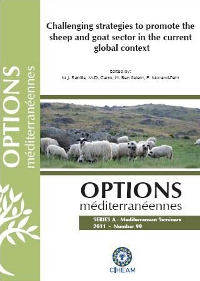| Article précédent | p. 133-139 | Article suivant |
Discrimination of different categories of forages harvested from North-western Italy according to near infrared reflectance spectroscopy, chemical composition and in vitro digestibility
Near infrared reflectance spectroscopy (NIRS), in vitro digestibility and fermentation kinetics data were used to discriminate categories of forage quality, based on the method of conservation, forage species, maturity stage or harvest season of 64 forages commonly used in ruminant production systems. Forages used in the study included 40 hay (H) and 24 silage (S) samples of Lolium multiflorum L., Medicago sativa L., Zea mays L. and grassland herbage harvested from 20 dairy cattle farms in Piemonte (N-W Italy). All the samples were scanned in duplicate (400 to 2500 nm) with a NIRSystems 6500 scanning monochromator, and the absorbance data were transformed by a second order derivative before being used in the principal component analysis (PCA). The chlorophyll absorbance in the visible region (650-690 nm) explained most of the variance in the spectra, so maize silage samples were classified apart from grass silage and hay samples. A similar classification was obtained when just the infrared region (1100-2500 nm) was used in the PCA; however, in this latter case the variables contributing to explain most of the response variation along the first two principal components were related to the starch and protein absorbance (2280-2300 nm). Hay samples were highly heterogeneous (different stages of maturity, different harvest seasons or cutting dates within a season, with simple or complex botanical composition), thus precluding discrimination or clustering according to the botanical composition when the absorbance data were used in the PCA. All forage samples could be classified correctly according to the type of conservation (H vs S) when combined data of chemical composition, in vitro digestibility and gas production kinetics were used in the PCA. However, in agreement with the results obtained for the absorbance data, with the information used in the PCA (gas production, in vitro digestibility or chemical data) it was not possible to discriminate different clusters according to the botanical composition, and no categories could be identified within each method of conservation. A proper discrimination of the botanical groups was not possible owing to the high heterogeneity of the samples included in the study, thus causing the overlapping of different clusters.
La spectroscopie à réflectance infrarouge (NIRS), la digestibilité in vitro et les cinétiques de fermentation ont été utilisées pour analyser la qualité de 64 échantillons de fourrages communément employés dans l'alimentation des ruminants. Les fourrages se distinguaient selon les espèces fourragères, les systèmes de conservation, le stade physiologique et la période de récolte. Les fourrages utilisés dans cette étude ont été : 40 foins (H) et 24 ensilages (S) de Lolium multiflorum L., Medicago sativa L., Zea mays L. et d'herbe de prairies récoltés dans 20 exploitations de vaches laitières du Piémont (N-O de l'Italie). Tous les échantillons ont été soumis deux fois au scanner (de 400 à 2500 nm) avec le NIRSystems 6500 scanning monochromator. Les données de l'absorbance ont été transformées par une dérivée de second ordre avant d'être utilisées dans l'analyse des composantes principales (PCA). L'absorbance de la chlorophylle dans la zone visible (650- 690 nm) explique une bonne partie de la variance du spectre, c'est pourquoi, les échantillons d'ensilage de maïs ont été classés séparément des échantillons d'ensilage d'herbe et des foins. Une classification semblable a été obtenue dans la PCA avec l'emploi de la région infrarouge (1100-2500 nm); cependant, dans ce deuxième cas, les variables qui ont contribué à expliquer une bonne partie de la variation le long des deux premières composantes principales ont été l'absorbance de l'amidon et de la protéine (2280-2300 nm). Les échantillons de foins étaient très hétérogènes (différents stades de maturation, différentes périodes de récolte ou de dates de coupe dans la même période de récolte, composition botanique simple ou complexe). Cela a empêché une discrimination ou un ensemble cluster sur la base de la composition botanique avec les données de l'absorbance dans la PCA. En utilisant la PCA, tous les échantillons de fourrages auraient pu être correctement classés selon le système de conservation (H vs S) avec les données de la composition chimique. Toutefois, en accord avec les résultats obtenus pour les données d'absorbance, aucune des informations utilisées dans la PCA (production de gaz, digestibilité in vitro ou données chimiques) ne portaient à clusters différents sur la base de la composition botanique, et aucune catégorie ne pouvait être distinguée selon la méthode de conservation. La discrimination de groupes botaniques n'a pas été possible à cause de la grande hétérogénéité des échantillons utilisés dans l'étude ce qui a causé la juxtaposition des différents clusters.
- [ Afficher ]
- [ Télécharger ]
- [ Exporter la citation ]
Vous pouvez télécharger la citation au format :
- [ Imprimer ]
-
Mots-clés
COMPOSITION CHIMIQUE, FERMENTATION, FOURRAGE, SPECTROSCOPIE INFRAROUGE, DIGESTIBILITE IN VITROCiter cet article
Opsi F., Tassone S., Fortina R., Andrés S., López S. Discrimination of different categories of forages harvested from North-western Italy according to near infrared reflectance spectroscopy, chemical composition and in vitro digestibility. In : Ranilla M.J. (ed.), Carro M.D. (ed.), Ben Salem H. (ed.), Morand-Fehr P. (ed.). Challenging strategies to promote the sheep and goat sector in the current global context. Zaragoza : CIHEAM / CSIC / Universidad de León / FAO, 2011. p. 133-139. (Options Méditerranéennes : Série A. Séminaires Méditerranéens; n. 99). 13. International Seminar of the Sub-Network on Nutrition of the FAO-CIHEAM Inter-Regional Cooperative Research and Development Network on Sheep and Goats, 2009/10/14-16, León (Spain). http://om.ciheam.org/om/pdf/a99/00801547.pdf



